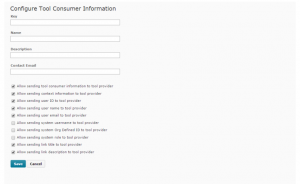So our current contract with our LMS vendor is complete in October 2018. I can’t say what we’ll do, but the landscape has changed somewhat since the last LMS review was done at work, so we’re starting to form a committee to look at our options. Ultimately, we’re doing this so far in advance because you should take at least a year to transition, which would put us at fall 2017 for starting to roll out the new system for users, which means that we’d need to know in the spring of 2017. Maybe the cost of change will scare us into another contract. As I see it, there’s four options available to us.
1. Stay with D2L. This is the easiest answer, and least complicated. We’ve been relatively happy with them as a company so there’s really no need to change, and despite the minor blips (the great outage of 2012) it’s been pretty smooth so far. Maybe continuous delivery will be awesome, and really a review of the LMS will be a mere formality.
2. Move to another hosted LMS. This is the second easiest answer – if the campus decides that D2L isn’t the choice for us, then we choose another vendor, enter into protracted negotiations, and go through the formal process of getting vendors to submit to review, tender offers, and go through the motions with selecting a new partner for the next five years. I’m not sure if the campus will think this is an option at all. Blackboard was our previous LMS, and didn’t work – essentially leaving the campus without a functional LMS for a whole semester. By the time it did start working, the relationship was in trouble, and well, that’s why we have D2L. That’s according to faculty who were here during the time it happened, which was prior to my time. Another seismic shift may not be in the cards. Another factor is that we’ve become a PeopleSoft school for our various systems across campus. That implementation has been rough for the campus. I’m not sure they have the appetite for another system to learn so quickly.
3. Go back to self-hosting LMS software. This allows us to look at open source solutions, and rely on our own IT group to take server maintenance, infrastructure and all the other associated risks back under our roof. It’s unlikely that we would do this due to the human cost of running a mission critical server – and we’d have to look at hiring back expertise that was relocated to other groups on campus or into industry. Those costs, are not insignificant. The complexity of running Moodle or Sakai at scale for 25,000 to 30,000 users, isn’t lost on me. It’d be a great challenge. I don’t know that this will be palatable to the campus either as we’ve had people who were running their own Moodle install come over to use the institution’s provided install of D2L. Maybe that’s the path of least resistance? Maybe it’s the students pushing for one platform? Who knows.
4. Do away with the LMS. This is an entirely radical idea, but what if we just left it up to instructors to do it themselves? I’d be ok in this scenario, despite having this a huge part of my job description, because there’s always going to be technology to use to teach. I’d have to adjust. Would this even fly? Probably not. Imagine the headlines: “first University to do away with the LMS”… would be useful to put on my tombstone after everyone lynches me because they need a secure webpage to link their stuff to.
As a teaching and learning centre, we’ll be interested in finding something flexible to teach not only in the modes that people currently teach in, but also in the pedagogy that people want to teach in. All LMS’s say they can do constructivist style setups, but really they require changes globally to do so. No one gives the instructor the power to turn on or off student control of a slice of content, or a discussion, or even a collaborative space for document sharing. I’ll go out on a limb and suggest that all LMS’s are designed as content delivery tools, not knowledge construction tools. And to that end, the choice of tools that can be used is often controlled by LMS administrators, not the instructors. Now, there’s great reasons for structuring things in such a way; theoretically administrators have subject matter expertise in selecting partners to connect to the LMS and have experience with vetting vendors. Right? I hope so. I know I’ve tried my best to make sure I’ve done right for student’s privacy, intellectual property and general safe digital space. I don’t know what I don’t know though. I guess, through the next three years, I’ll start to find out.
